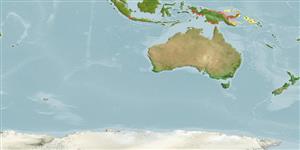Environment: milieu / climate zone / depth range / distribution range
Ecologia
marinhas; Água doce; estuarina; não migratória. Tropical; 2°S - 10°S
Southwest Pacific: known from several sites but probably extends from Toro Pass near the mouth of the Fly River (Papua New Guinea) to Vogelkop Peninsula, Irian Jaya, and from Woods Inlet in Darwin Harbor, Australia.
Tamanho / Peso / Idade
Maturity: Lm ? range ? - ? cm
Max length : 3.5 cm TL macho/indeterminado; (Ref. 9786)
Descrição suscinta
Morfologia | Morfometria
Espinhos dorsais (total): 3 - 4; Raios dorsais (total): 5-6; Espinhos anais 1; Raios anais : 10 - 12. Predorsal scale count 14 to 17. Sexual dimorphism not apparent in this species.
Found in mangrove swamps and saline creeks (Ref. 9786, 44894). Occurs infringing coastal mangroves in brackish or marine waters. Aggregations shelter among submerged roots or inundated leaves and branches (Ref. 44894). This is a planktivorous species which adapts well to freshwater environment. May occur in large schools, frequently in muddy waters. Sympatric with P. cyanodorsalis over part of its range (Ref. 9786). Probably more widespread, but has escaped notice due to its small size and largely inaccessible habitat (Ref. 44894).
Ciclo de vida ou comportamento de acasalamento
Maturidade | Reprodução | Desova | Ovos | Fecundidade | Larvas
Ivantsoff, W., 1999. Order Atheriniformes. Pseudomugilidae. Blue eyes. p. 2109-2112. In K.E. Carpenter and V.H. Niem (eds.) FAO species identification guide for fishery purposes. The living marine resources of the Western Central Pacific. Volume 4. Bony fishes part 2 (Mugilidae to Carangidae). FAO, Rome. (Ref. 9786)
Status na Lista Vermelha da UICN (Ref. 130435)
Ameaça para os humanos
Harmless
Uso pelos humanos
Pescarias: sem interesse
Mais informação
Nomes comunsSinônimosMetabolismoPredadoresEcotoxicologiaReproduçãoMaturidadeDesovaAgregação de desovaFecundidadeOvosDesenvolvimento dos ovos
Idade/TamanhoCrescimentoPeso-comprimentoComprimento-comprimentoFrequências de comprimentoMorfometriaMorfologiaLarvasDinâmica larvalRecrutamentoAbundânciaBRUVS
ReferênciasAquaculturaPerfil para aquaculturaEstirpesGenéticaElectrophoresesHereditariedadeDoençasProcessamentoNutrientsConversão de massa
ColaboradoresFotosStamps, Coins Misc.SonsCiguateraVelocidadeTipo de nataçãoÁrea branquialOtólitosCérebrosVisão
Ferramentas
Relatórios especiais
Baixar XML
Fontes da internet
Estimates based on models
Preferred temperature (Ref.
123201): 27.9 - 29.1, mean 28.7 °C (based on 249 cells).
Índice de diversidade filogenética (Ref.
82804): PD
50 = 0.5000 [Uniqueness, from 0.5 = low to 2.0 = high].
Bayesian length-weight: a=0.00389 (0.00180 - 0.00842), b=3.12 (2.94 - 3.30), in cm total length, based on all LWR estimates for this body shape (Ref.
93245).
Nível Trófico (Ref.
69278): 3.4 ±0.45 se; based on food items.
Fishing Vulnerability (Ref.
59153): Low vulnerability (10 of 100).
